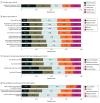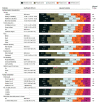Plans of US Parents Regarding School Attendance for Their Children in the Fall of 2020: A National Survey
- PMID: 32797152
- PMCID: PMC7428818
- DOI: 10.1001/jamapediatrics.2020.3864
Plans of US Parents Regarding School Attendance for Their Children in the Fall of 2020: A National Survey
Abstract
Importance: As schools consider reopening for in-person instruction prior to availability of a coronavirus disease 2019 (COVID-19) vaccine, families may be weighing their priorities regarding school attendance.
Objective: To characterize the association of planned in-person school attendance during the COVID-19 pandemic with factors, including family socioeconomic characteristics, and parent attitudes and beliefs about their child's school attendance.
Design, setting, and participants: Cross-sectional survey study. Data were collected from June 2, 2020, to June 5, 2020, weighted to reflect population norms, and analyzed using ordered probit regression. A sample of US parents (of children ages 5-17 years) were recruited using a nonprobability survey panel with stratification by socioeconomic characteristics.
Main outcomes and measures: The main outcome was parent-reported plan to send their child to school or keep their child home, conditional on their school opening for in-person instruction. Additional measures assessed family socioeconomic characteristics, medical vulnerability, worry about COVID-19 and multisystem inflammatory syndrome, confidence in their child's school, and homeschooling difficulties.
Results: The sample of 730 parents was balanced by parent sex (53% women) with successful oversampling for Black (28%; n = 201) and Hispanic (27%; n = 200) participants. In estimates weighted to US population norms, 31% (95% CI, 27% to 34%) of participants indicated they would probably or definitely keep their child home this fall, and 49% indicated that they would probably or definitely send their child to school this fall. Factors associated with planning to keep children home included lower income (38% with incomes <$50 000 vs 21% with incomes $100 000-$150 000 per year; difference, 17%; 95% CI, 9% to 26%), being unemployed (40% unemployed vs 26% employed; difference, 14%; 95% CI, 5% to 25%), and having a flexible job (33% with flexible jobs vs 19% with inflexible jobs; difference, 14%; 95% CI, 5% to 30%). Planning to keep children home was also associated with fear of COVID-19 (B = 0.19; P < .001), fear of multisystem inflammatory syndrome (B = 0.12; P = .04), confidence in schools (B = -0.22; P < .001), and challenges of homeschooling (B = -0.12; P = .01). Race and ethnicity were not significantly associated with plans to keep children home.
Conclusions and relevance: In this survey study, many parents planned to keep children home in fall 2020. Schools need to act soon to address parental concerns and provide options for what will be available for them should they opt to keep their child home. Structural barriers, such as lack of workplace flexibility and potential school-level inequities in implementation of preventive measures, must be acknowledged and addressed where possible.
Conflict of interest statement
Figures
Comment in
-
Returning to School in the Era of COVID-19.JAMA Pediatr. 2020 Nov 1;174(11):1028-1029. doi: 10.1001/jamapediatrics.2020.3874. JAMA Pediatr. 2020. PMID: 32797162 No abstract available.
References
-
- Kuhfeld M, Soland J, Tarasawa B, Johnson A, Ruzek E, Liu J Projecting the potential impacts of COVID-19 school closures on academic achievement. EdWorkingPapers.com. Published online May 4, 2020. Accessed June 5, 2020. https://www.edworkingpapers.com/ai20-226
LinkOut - more resources
Full Text Sources
Research Materials



